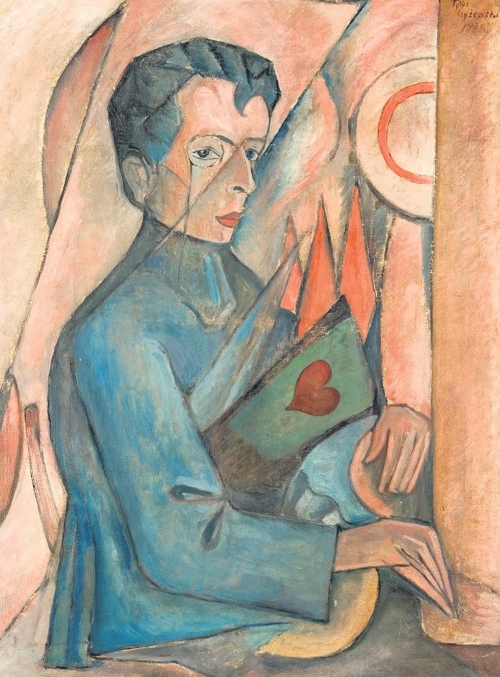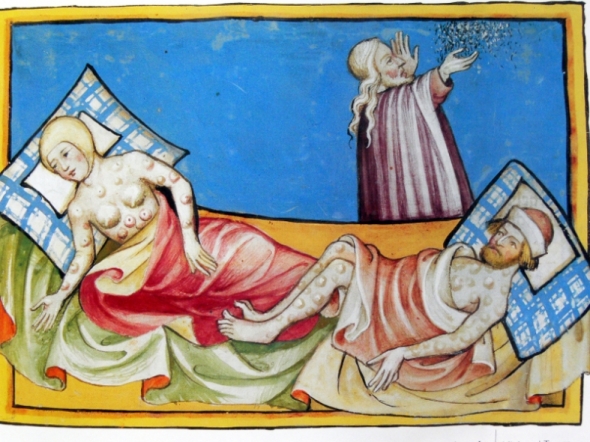Microbial Communism
Communist futurist Bruno Jasieński's incredible novel, I Burn Paris, casts a plague upon the crisis-ridden Paris of the 1930s as the backdrop to a cycle of civil war, revolutionary defeat and eventual victory. Benjamin Noys reviews this recently recovered classic
Speaking to Arthur Ransome in 1919 Lenin remarked that he believed that revolution was imminent in England. He went on
We have a saying that a man may have typhoid while still on his last legs. Twenty, maybe thirty, years ago I had abortive typhoid and was going about with it, had had it some days before it knocked me over. Well England and France and Italy have caught the disease already. England may seem to you untouched, but the microbe is already there.1
We are used to the metaphor of communism as disease as a reactionary trope, but Lenin’s remarks suggest that it could be positively adopted. This is the position of Bruno Jasieński’s remarkable apocalyptic novel I Burn Paris, which was serialized in the French Communist newspaper L’Humanité in 1928, and is now reissued in a beautiful edition by Twisted Spoon Press.
Jasieński himself is a remarkable character. Born in 1901, he became a Futurist and in 1921 published the manifesto ‘To the Polish Nation: A Manifesto on the Immediate Futurization of Life’. He also published the poem ‘Nic’ (‘Nothing’), which contained not a single word. By 1923 Jasieński had exhausted Futurism, and began his commitment to communism. His fellow Futurist Witold Wandurski had said the choice was Revolution or masturbation.2 In 1925 Jasieński moved to Paris and chose revolution.
The novel begins with a worker Pierre, who has been made unemployed just as his girlfriend Jeanette demands a new pair of evening slippers. The faithless Jeanette doesn’t wait and Pierre, who is already behind with his rent, takes to living on the streets. Pierre is defiantly apolitical, believing
No one would budge the diabolical machine, not one inch! It had grown deep into the earth. It had been running since time immemorial, ever since it had been set in motion. Seize the cogs with your bare hands? It wouldn’t stop, it would just rip off your hands.3
Meeting a childhood friend, René, who shows off his new workplace at a bacteriological institute, Pierre steals two vials of a new bubonic plague and dumps them in the Paris water supply. One of the first victims is Pierre’s girlfriend. In grief as a result Pierre proclaims his crime to the crowd: ‘There was nothing to punish you! I am your punishment! I’m the one who poisoned you like rats!’.4 He is beaten to death: ‘there was nothing more than a motionless, red splotch left on the sidewalk.’5 The nihilist catastrophist dies so that microbial communism might be born.

Image: Tytus Czyżewski, Portrait of Bruno Jasieński, 1920
As the disease spreads Paris is quarantined. It then fragments into independent states along ethnic, religious, and political lines; from Monarchists, White Russians to the Belleville Soviet Republic. This is a surreal communist version of Chesterton’s Napoleon of Notting Hill (1904), with its warring London boroughs. Far from Chesterton’s bucolic medievalism Jasieński’s vision is of pogroms, class war, and that universal equaliser which is death by plague. The communist microbe merges with bacterial warfare as the remnants of bourgeois society, and the nascent forms of communism, are swept into death. The only redemption is for communists with faith in the idea, as one communist dying of plague reports to his White guard brother: ‘People like us don’t die. We’ve grafted our roots in the masses, in the species. Our every fiber has grown into them.’6 The response is that the White guard adopts his brother’s communist identity before committing suicide.
Eventually Paris is cleansed by plague until all that remains are the inmates of the prisons, which include workers and party members rounded up at the start of the novel. It is they who will rebuild. Hiding their identity from the outside world for fear of destruction this new group of communist leaders are in harmony with the party members on the plan to create an enclave of communism before broadcasting their message to the world by radio. One leader sketches the plan:
Instead of the plague, which was to have spread across the entire world, but in fact only made room to start building anew, we hereby ignite the great plague of the idea that will spread across this old continent in a sea of cleansing fire, scorching the armies, cordons, and borders.7
As the outside world engineers a war on Soviet Russia, the new Paris Commune announces itself and the novel ends with a radio broadcast by the communists constantly interrupted by a popular song of cheap seduction from the radio station it is overriding. In the last line we are told the masses are ‘pushing forward’.8
Due to the success of the novel Jasieński was expelled from France for disseminating political propaganda and the book banned as it ‘exuded blind and stupid hatred for Western European culture.’ He fled to the Soviet Union, where he received a hero’s welcome; I Burn Paris had been a bestseller, selling out its first edition of 140,000 copies. Jasieński continued to write and was an ardent Stalinist.9In 1937 he was arrested, tortured (sending Stalin letters detailing his tortures and begging for death), before eventually being shot on 17 September 1938 in Moscow’s Butrya prison.
When today communism is often figured in terms of contagion, resonance and transmission between living bodies, Jasieński’s novel makes uncomfortably resonant reading. Jasieński’s apocalyptic vanguardism sees catastrophe as clearing the way for organisation and the plan. Violent cleansing is merely prelude to another violent slicing and rearranging of the proletariat: ‘To tear this highly combustible crowd from its unbridled elation and channel it into concrete action, they had to yank out its seams and splice it with the scissors of organization.’10 The instability of the novel is that this new compact proletariat is itself produced by prison, and the combination of the elite of party and workers with thieves and other criminals. Jasieński’s dialectic of rotting dispersion and tailored compactness traces a fantasy space in which, too often, we still dwell.
Benjamin Noys <b.noys AT chi.ac.uk> teaches at the University of Chichester and his most recent book is The Persistence of the Negative (2010). He is currently completing a critique of accelerationism that will appear with Zero Books in 2014 titled Malign Velocities: Speed and Capitalism
Info
Bruno Jasieński, I Burn Paris, trans. Soren A. Gauger and Marcin Piekoszewski, Prague: Twisted Spoon Press, 2012.
Footnotes
1 ‘Talks with Lenin’, Evening Post, Rōrahi XCVIII, Putanga 40, 16 Hereturikōkā 1919, p.10, National Library of New Zealand: http://paperspast.natlib.govt.nz/cgi-bin/paperspast?a=d&d=EP19190816.2.85&l=mi&e=-------10--1----0
2 Marci Shore, ‘A Worker’s Revenge’, Times Literary Supplement, 22 June (2012), p.10.
3 Bruno Jasieński, I Burn Paris, trans. Soren A. Gauger and Marcin Piekoszewski, Prague: Twisted Spoon Press, 2012 p.38.
4 Ibid., p.64.
5 Ibid., p.65.
6 Ibid., p.213
7 Ibid., p.281.
8 Ibid., p.302.
9 I’d like to thank Guiliano Vivaldi, who has traced sources which tell us that Jasieński’s Russian writings include a retelling of Gogol’s ‘The Nose’ in which an Aryan professor of eugenics wakes up one day with a ‘typical’ Semitic nose It changes his life and he tries to work out a plan to wipe out the leaders of the Third Reich. His socialist realist novel Человек меняет кожу (Man changes his skin) (1934) had most critical success, although also provoked criticism from Stalin, which Jasieński replied to in a letter written in June 1934. There was also a Soviet TV serial of ‘Man Changes Skin’ scripted by two of the best Soviet-era scriptwriters – Valeri Frid and Yuli Dunsky in 1979.
10 I Burn Paris, op.cit., p.282.
Mute Books Orders
For Mute Books distribution contact Anagram Books
contact@anagrambooks.com
For online purchases visit anagrambooks.com







